#and then I decided to name all sheep medieval irish names
Explore tagged Tumblr posts
Text
Realizing making a goat design means I’m going to have to find another fucking medieval irish name OTL
Ramble in tags:
#my lamb is named Úna which originated in medieval Ireland and literally means ‘lamb’#which is why I chose it#and then I decided to name all sheep medieval irish names#which was a mistake bc there are very few that don’t have wild spellings and/or pronunciations#lamb’s sister is names Isibél which was hard enough to find and verifiy that it actually was used in that time period#now I gotta find another#my Goat didn’t come from an alternate universe they were created and have a sibling like relationship to lamb#so i gotta give them a appropriate name#sigh *opens behindthename.com*#jordan being allergic to shutting up
11 notes
·
View notes
Note
What are the major details that confused you about the Hound blurb? The major one that stood put to me was the "way of the farmer opposed to the sword" thing which felt very...un-Cú Chulainn. Also, if you don't mind expanding further, which details didn't you question/be confused by?
and also for anon:
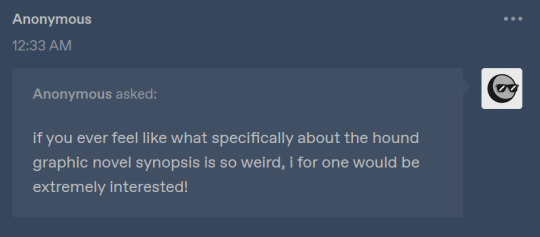
okay so it is like. 2am so there are not going to be any sources here but i can't sleep so here goes!! i will go through this blurb line by line and give youse my thoughts
In 50 BCE,
reasonable. this is roughly the right time period for when the ulster cycle is set. maybe marginally earlier than i'd place cú chulainn, but i'm talking a few years, nothing to get worked up about.
Morrigan, the goddess of war,
fine. normally i'm wary of pantheonising impulses with regard to irish characters (almost none of them can be identified as a god of anything in particular, it doesn't work like that) but tbh the morrigan is like, the most plausible exception to that, so whatever. normally her name has the definite article attached to it because it's kind of a species term as well but whatevs.
has become restless as a long-lasting peace settles over Ireland.
dubious. closest i can think of to peace being reference in any texts is togail bruidne da derga talking about conaire mor's reign being like, prosperous and peaceful and whatever, and even there you've got díberg (plundering/reaving) which is what eventually fucks him over and starts the otherworldly hell spiral situation. that's roughly the right period here but conaire's doom proves you don't have to do much to nudge peace into war, and connacht and ulster are at each other's throats for years before cú chulainn comes on the scene anyway
Deciding the time of peace must end, she chooses Setanta, the nephew of the king of the north, to become her ward.
hmm. i mean. like, this isn't the WEIRDEST choice they could have made. it's still completely made-up, don't get me wrong -- cú chulainn has a lot of different foster parents in different texts and they don't agree with each other but none of them ever mentions the morrígan. but like, they do have a connection of some sort, as evidenced by their conversations. and there's that one moment in the r1 boyhood deeds where little cú chulainn is out on the battlefield and hears her (not sure which name is used here) calling out to him and it like. motivates him to do some deeds or whatever, and i guess you could extrapolate that into some kind of teaching capacity.
so like. could be weirder. if you're gonna pick anyone, you could do worse. still seems weird to me! but not on its own a major issue, i could get past this and consider it a Fun But Unorthodox Creative Decision
(the fact that she tries to seduce him in the táin probably wouldn't get in the way of this considering sleeping with his teachers/foster-mothers is far from unheard of where cú chulainn is concerned)
After a young Setanta slays the demon-hound of Cullan, he becomes known as Cú Cullan—The Hound of Cullan.
weird spelling choices, they could have at least bothered to use the genitive properly. also the hound isn't a demon, it's a ferocious watchdog -- making it sound all Otherworldly and Hellish like this kinda confuses the issue of why he would need to take its place. he needs to take its place because the cattle and people still need protecting because it is a watchdog!! but whatevs, again, it's a brief summary so they can't exactly give us all the details and this is not actively objectionable
As Cú Cullan grows older, it is apparent that an extraordinary power lies within him … and a great darkness.
ugh boring. this makes it sound like he's going to be ~tortured~ and angsty about it. give me an unapologetic murder teen please. is the ríastrad dark? sure i guess, if you're going to be boring about it. it's more like, grotesque neon in my head
When he chooses the quiet life of a farmer over the sword,
this would fucking never happen on like five different levels. obviously like anyone who has ever read anything about cú chulainn can see that this is not in his nature. he is never going to choose a quiet life. this is the kid who tricked his way into taking arms before everyone thought he was ready. also juxtaposed with the "darkness" comment makes it sound like he would Angst his way into this quiet life which. again. have you seen this kid. he is an unapologetic murder teen
the only thing i can think of that might make him temporarily want to walk away is connla's death which... depends where you position that in the timeline really, he does seem a bit fucked up by it and maybe he'd want a holiday although i can see that lasting precisely 5 minutes before someone pissed him off enough for him to murder them. but if he's being raised by the morrígan i can't see him going to train with scáthach so then he'd never meet aífe and therefore connla would never be born so that wouldn't happen. so like. whatever.
but also like. he would not become a farmer. he just wouldn't! it doesn't work! the ireland of the stories is super hierarchical, right? and this blurb has already fucking told us that he's the king's nephew (canon) so we can tell that being a farmer is Not His Place. when we see upper class figures becoming menial labourers in texts, like in cath maige tuired, it's because Things Are Fucked, Shit's Gone Wrong. people don't just decide to change their entire social class on a whim lmfao
if cú chulainn really wanted to turn his back on being a warrior he could probably make recourse to certain other Suitable Professions ... his grandad's a druid so he might have a route into that, though his dad's not so that might fuck things up a bit bc it's one of those things that's usually inherited. he does give "wisdom" in at least one text though and we also know he can write (he carves riddles in ogham in the táin) and he composes verses on various occasions so idk, maybe something in a poetic direction, though again, usually requires two generations of inheritance to be a real poet and not just a lower-class bard. warrior's kinda the main thing he's got open to him tbh. but farming? i'm not a legal expert but as far as i'm aware based on what i have read, that would fuck shit up
more likely an upset cú chulainn would just go off in search of an adventure somewhere conveniently far away until he'd calmed down (alba, or the tyrrhenian sea, or -- if we're going to get early modern about it -- somewhere like india, which frequently gets thrown into the texts with absolutely no cultural context and it's always hilarious)
Morrigan, angry at the betrayal,
of the entire social order, yes,
instigates an invasion of his homeland
i mean. if they intend this to be the táin then.... táin bó regamna does kinda make the morrígan responsible for it? not in the sense of triggering the pillow talk argument that it's in the book of leinster -- it's her getting up to her usual cow-nicking behaviours for shits and giggles. [note to readers: it is probably for more than shits and giggles but did i mention it's 2am]
but all in all, not particularly out of character that she would be at least some way responsible for this so i can vibe with this. echtra nerai also supports the TBR explanation with her fucking around with otherworldly cows and pissing people off so, yeah, whatever. the morrígan engineered this. sure.
and Cú Cullan must challenge fate itself
this is probably a controversial stance but fate feels like a difficult concept to apply to medieval irish texts. like are people sometimes Doomed? yes. there are prophecies, there are gessi, there's all manner of otherworldly fuckery that can trip you up. is that the same thing as fate? no idea. considering cú chulainn comes out alive from the táin though and his doom prophecies don't catch up to him for like, at least another decade, maybe 16 years depending on who you listen to, hard to see how that would apply here
to keep the goddess at bay.
again like she IS causing fuckery in the táin but also it's like... one time. really not the main character. but she or maybe just some crows, hard to say, do get implicated in the death tale so maybe they're doing what people often do and conflating the two? even though there's like 10-16 years in between them?
anyway as you can see i don’t think it’s wholly terrible / i’m not completely thinkshaming it. like, having cú chulainn raised by the morrígan is unorthodox but it could be a fun and creative direction so i don't object to it. making cú chulainn get sad about murder and choose to be a farmer is just fucking laughable tho, and makes me doubt their characterisations in general. so that's offputting and would probably make me think twice about buying it, if that had ever been on the cards.*
and of course sure, their cú chulainn can be a Sad Boy Who Likes Sheep, but that means he's not the cú chulainn of medieval irish lit / irish myth, because that cú chulainn is a feral murder teen who keeps killing his friends and also is way too high social status to ever be a farmer, and whose only relationship to livestock is as the watchdog who kills anyone trying to harm them (which is an important role on a farm! but like. not the same thing as Being A Farmer. mostly because it involves more murder and is essentially just an extension of his role as a warrior. or rather the other way around. he promises to protect mag muirthemne as a watchdog and this like. gets extended into him becoming its sole defender)
this has been my analysis of this blurb i hope you enjoyed it
it's now 2.30am i should try and sleep now that i've exorcised a few thoughts from my head
*as i mentioned in the tags of my other post, i don't tend to read graphic novels due to disability stuff. they're much harder for me to understand and follow than prose, to the point where some are incomprehensible, so i don't really enjoy them. there are a few i've read, but they tend to be short ones, and i'm usually not reading them in order, just admiring the art separately from the text. so it's unlikely i would read a graphic novel of this size anyway.
#cu chulainn#hound#hound graphic novel#answered#oddnub-eye#anonymous#irish mythology#medieval irish#tain bo cuailnge
18 notes
·
View notes
Text
Day 125: Hadrian’s Wall and the Scottish Borders

When we first started planning this trip, one of the big sites I'd wanted to see was Hadrian's wall. But it's so far from anywhere else we wanted to go in England that I had resigned myself to the fact that I probably wouldn't get to go. Luckily, Rabbie's offers a tour of the wall from Edinburgh. Not only would we get to see Hadrian's Wall, we'd get to approach it from the north like an old Celtic barbarian.
It was a long tour, so we had to get up and into town early.
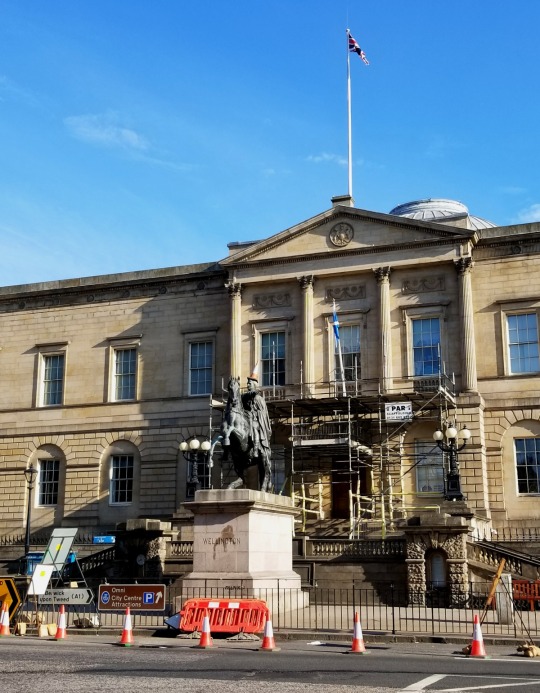
There must have been quite the party going the night before. Even the statues woke up with traffic cones on their heads.
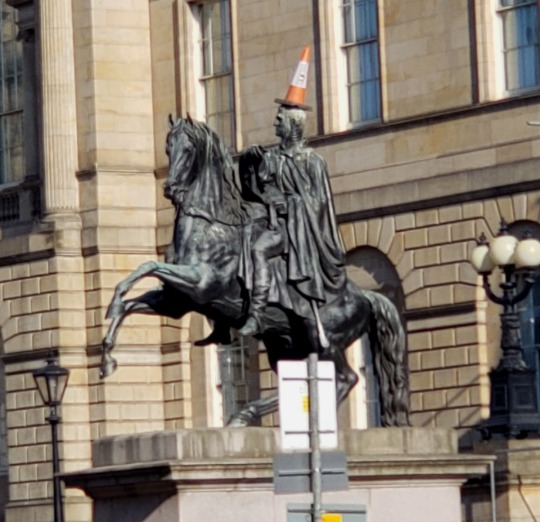
Our guide and driver for the day was Nik, a middle-aged, born-and-bred Edinburgh man with the accent and stories to prove it.
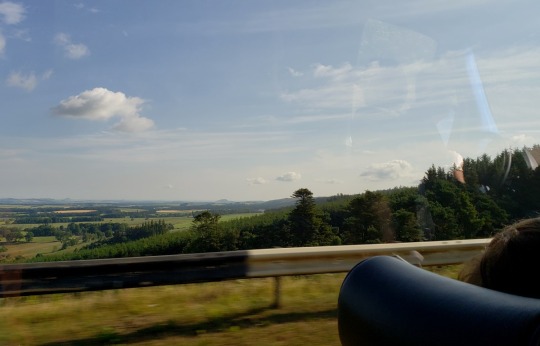
As we drove south, we passed through the beautiful rolling hill country that makes up the Scottish Borders. The Highlands are seem to get all the glory when it comes to romanticizing Scottish countryside, but the Lowlands definitely have their own idyllic charm.
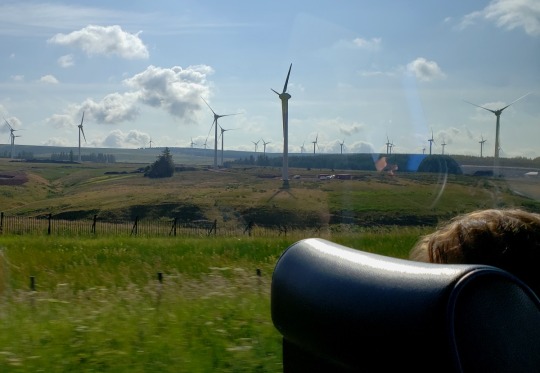
Nik told us some interesting stories about the medieval residents of the Borders and their complex relationship between England and Scotland. They were ethnically Scottish, but the Borderers resented both countries because their wars inevitably brought the razing and pillaging of border towns by both sides.
The Borderers were excellent horse riders and highly valued as mercenary cavalrymen throughout Europe. Whenever the English and Scottish armies fought in the Borders, the Borderers would hire themselves out to both sides, then sit on the sidelines of each battle until the winner was clear. They made special coats with English colors on one side and Scottish colors on the other, so they could flip their coats inside-out to match whichever side they decided to be "fighting for" at the moment. Hence the term "turncoats."
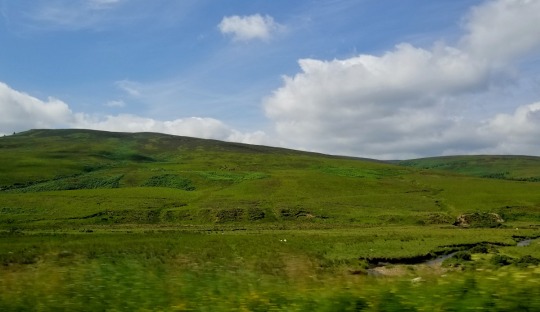
When they weren’t fighting as mercenaries, the Borderers spent a lot of time fighting themselves. One town would gather a raiding party and invade the next town over. That town would then gather a counter-raid to get their stuff back. Eventually, the raids became so bad that towns hundreds of miles away–well outside the Borders--were being raided by these crazy hill people. Neither country wanted to take responsibility for them, but when King James VI and I united Scotland and England under one crown, he was able to raise a police force to move in and establish order.
We also saw a lot of sheep on our drive. According to Nik, there are three sheep in Scotland for every man, woman, and child. Which is the perfect number, he said–one for meat, one for wool, and one for snuggling.
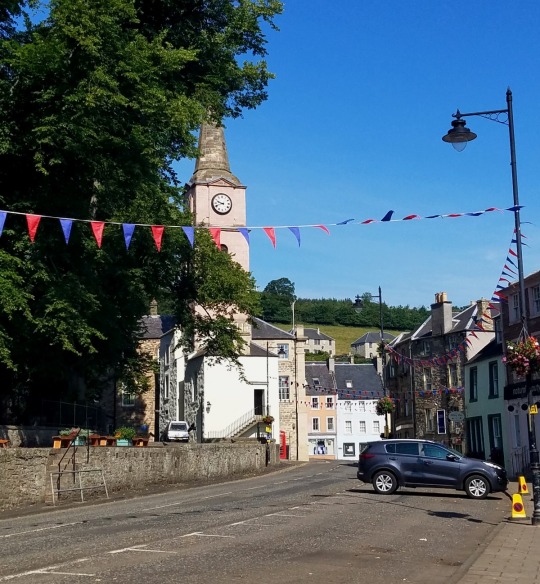
Our first stop was the abbey town of Jedburgh, just ten miles north of the border with England. Streamers hung up all over the town indicated that a festival was going on, but it was dead quite on this Thursday morning.
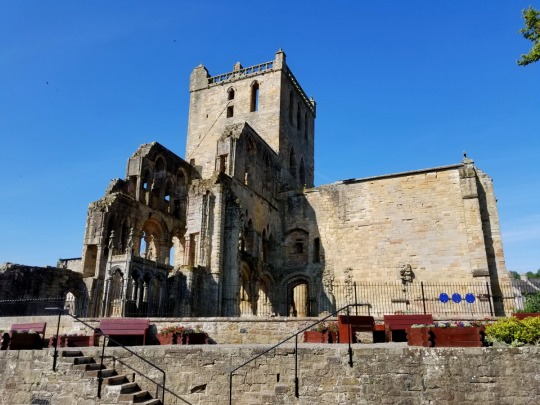
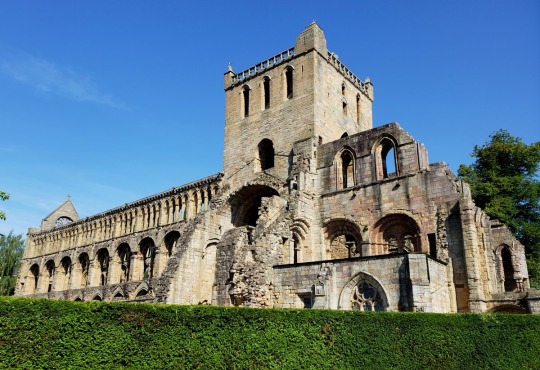
The abbey, like most abbeys in Britain, is only a picturesque ruin now. But this time it wasn't Henry VIII's fault--the Scottish destroyed their own abbeys during their own Presbyterian Reformation.
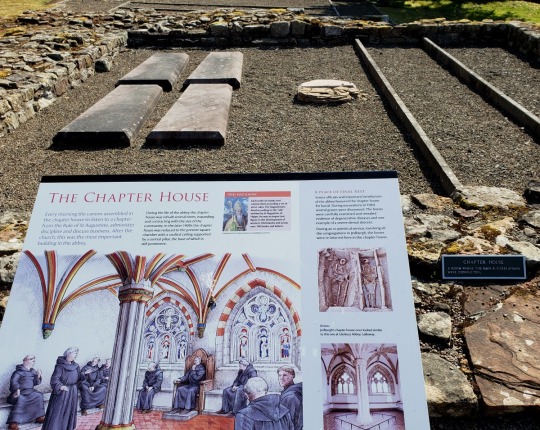
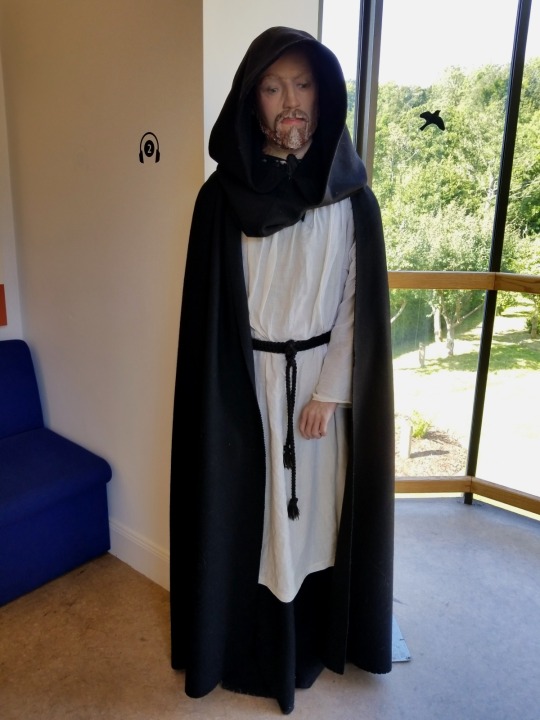
Before its destruction, the abbey was inhabited by Augustinians, who were known as cannons rather than monks. Whereas monks live and work in their abbey, cannons are priests who choose to live communally in an abbey but still teach and perform services in their local community.
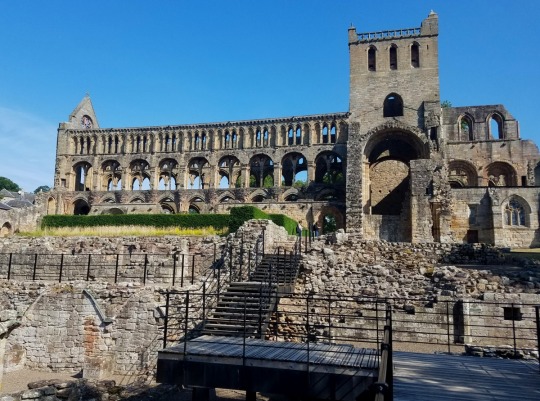

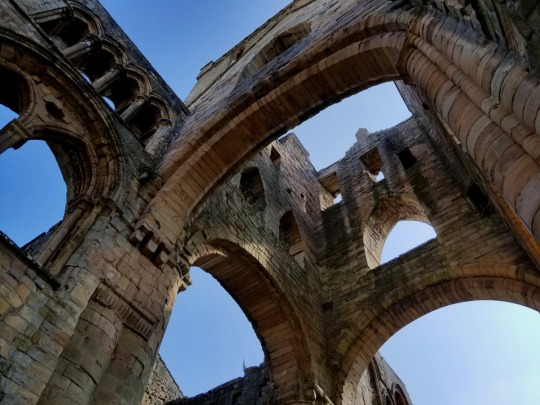
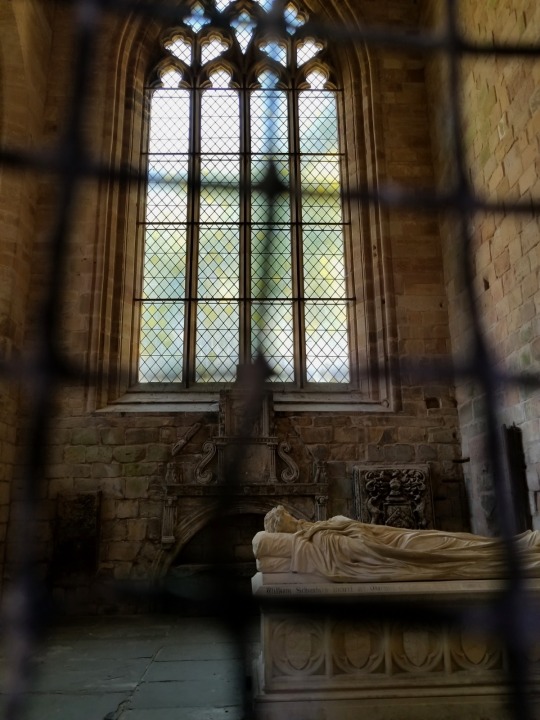
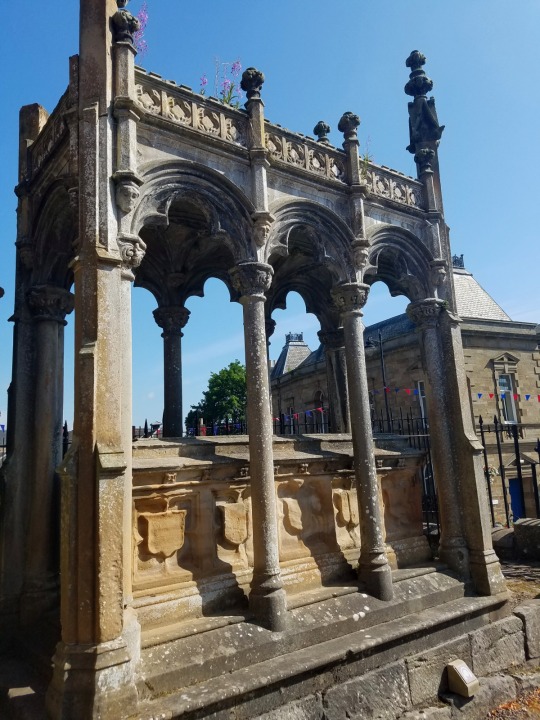
We got about an hour to explore the small museum and wander through the peaceful ruins.
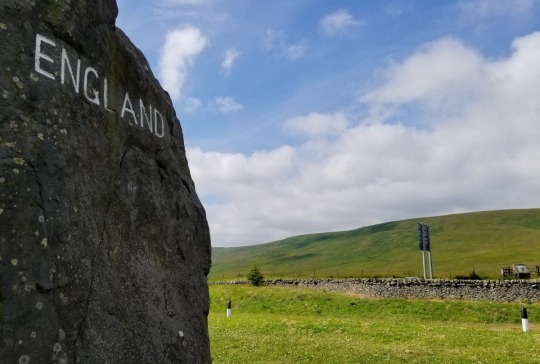
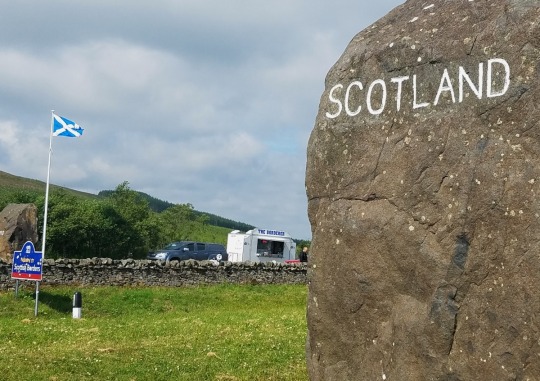
Next we headed down to the crossing between England and Scotland, where we pulled over for a quick photo op. There's no security or anything, just a pair of engraved standing stones.
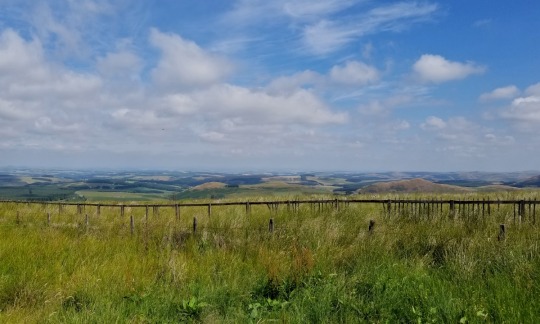
The view was fantastic, though.
Our timing was good, too. Just as our group finished taking pictures, a kilt-clad busker showed up to serenade us with his bagpipes. More oddly, a man driving through the parking lot stopped and called one of our group mates over so that he could give her some sort of "helpful" pamplet. According to Nik, this guy is a regular feature at the crossing who stages this sort of thing all the time, making it seem like he's just a friendly local who randomly decided to pull over and give the handout to a passing tourist.
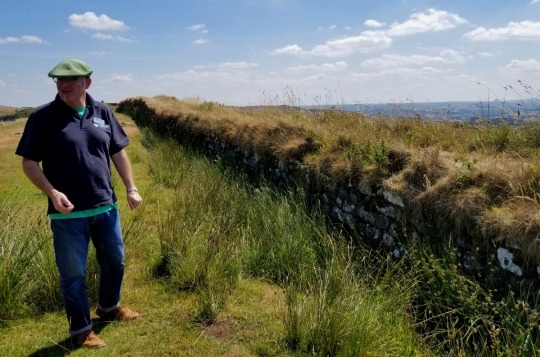
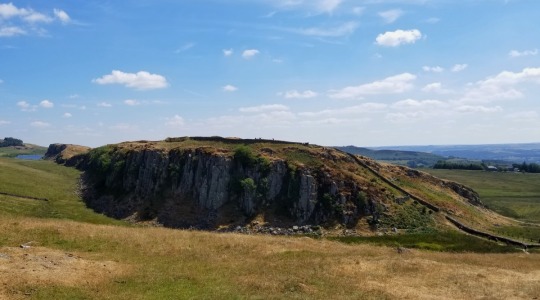
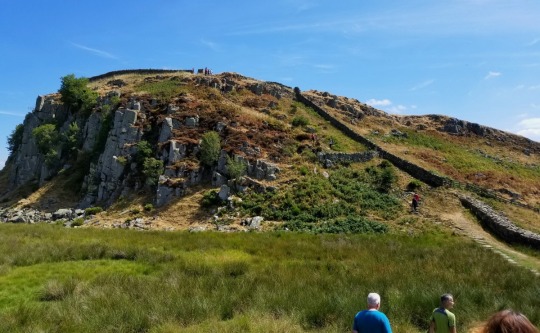
After a few very pleasant hours of driving (some of which my dad and I might have spent dozing), we arrived at Hadrian’s wall. Specifically, we arrived at Steel Rigg, a dramatic line of glacial crags that the wall runs along the top of.
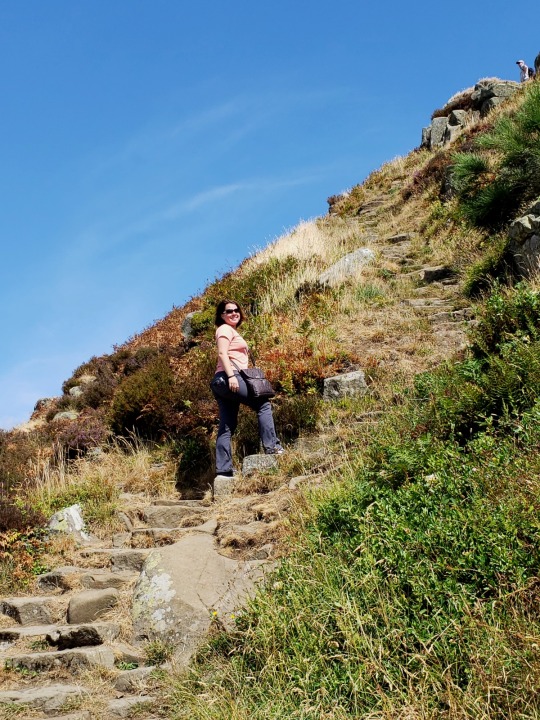
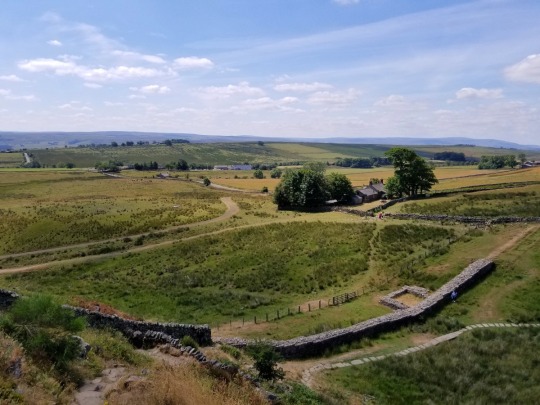
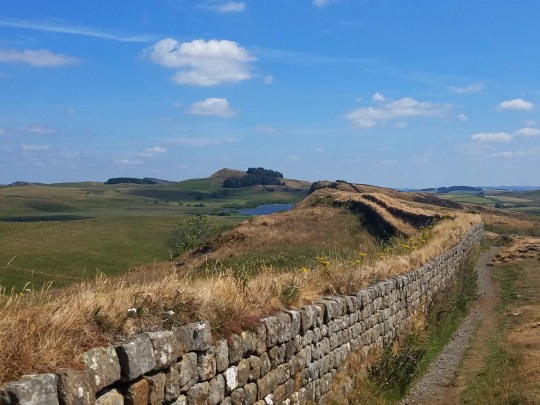
It was a steep climb up to the top of the outcrop, but the view was well worth it. Even if the wall was never really used as a defensive installation, it was easy to imagine hordes of painted Celtic barbarians massing to the north.
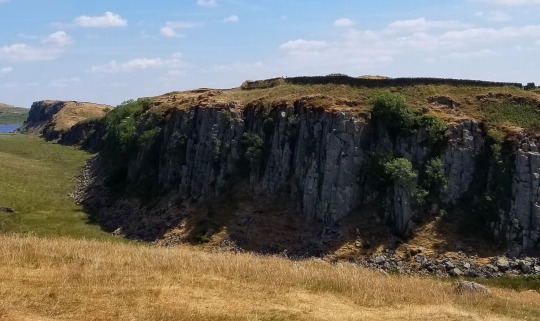
And seeing the way crags rise up like a wall themselves, I can very easily understand how George R.R. Martin was inspired by this place to create his fictional wall of ice in A Game of Thrones.
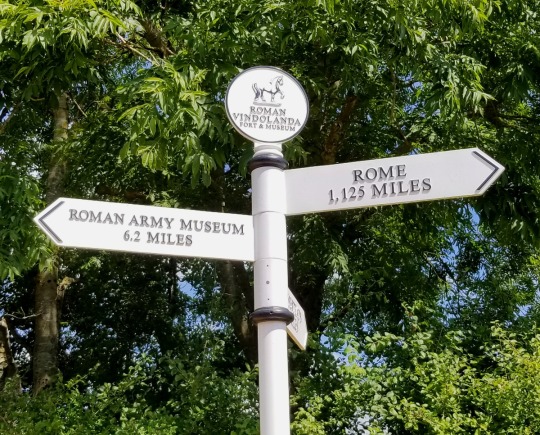
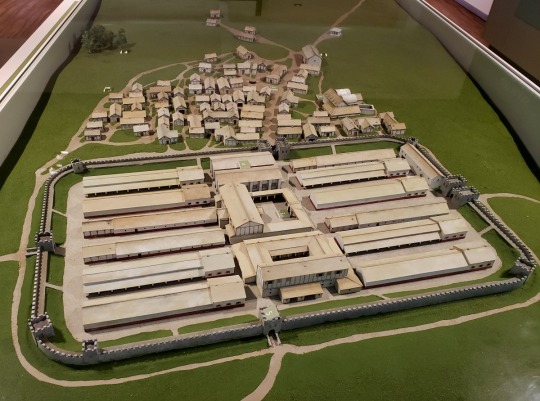
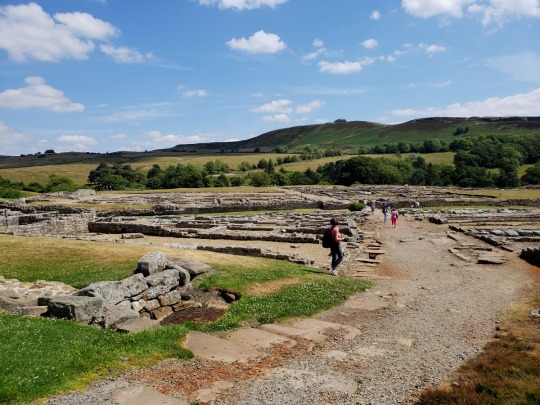
Next, we went to the nearby Vindolanda excavation and museum. Vindolanda was a Roman walled settlement inhabited by the soldiers who manned Hadrian's wall, as well as their families and the various merchants and artisans who supplied them. The site has been meticulously unearthed, and the included museum is filled with fascinating artifacts from the Roman inhabitants’ everyday lives.
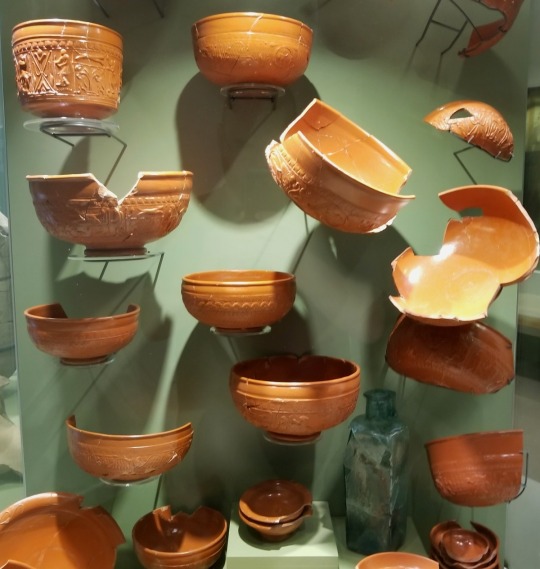
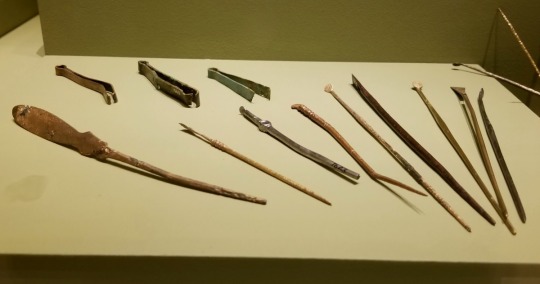
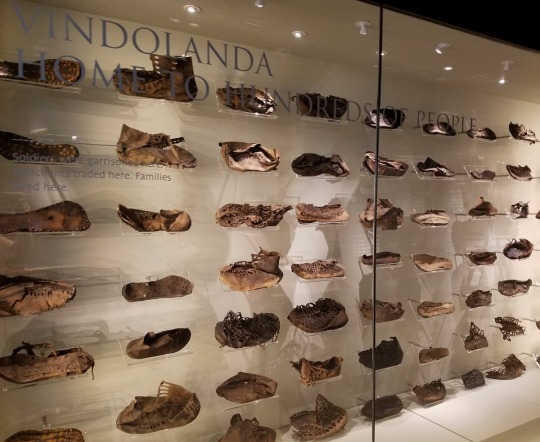
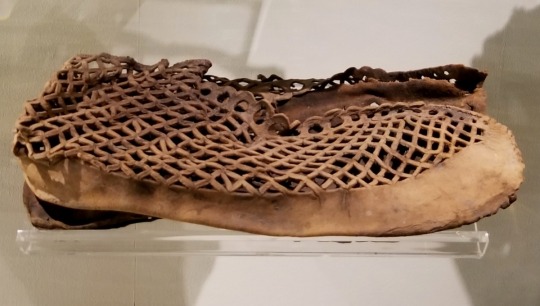
There was pottery, flatware, tweezers, and lots and lots of leather shoes. The Romans wore very intricate leather shoes, but apparently very few examples are still around. Vindolanda is a treasure trove of leather and wooden goods because the land it's on is basically a bog--pretty much the same story as with the Celtic artifacts we saw at the Irish National Museum of Archeology in Dublin.
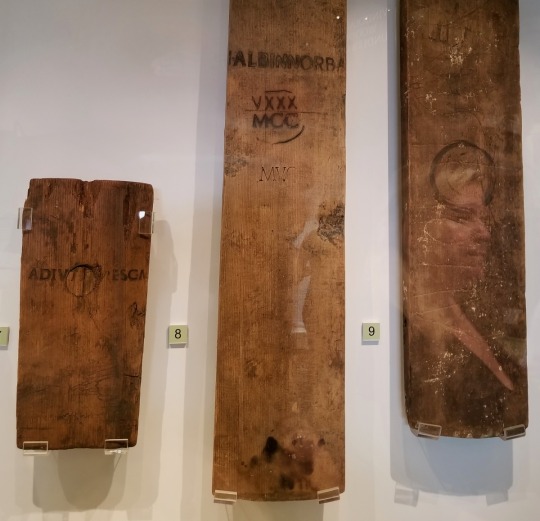
Despite being such innocuous pieces, one of the collections that struck me the most was the wooden barrel staves on display. We could see the ancient branded markings in old Latin clear as day, and one stave still bore a round stain from when some Roman set something dirty on it. The world's oldest coffee ring, perhaps?
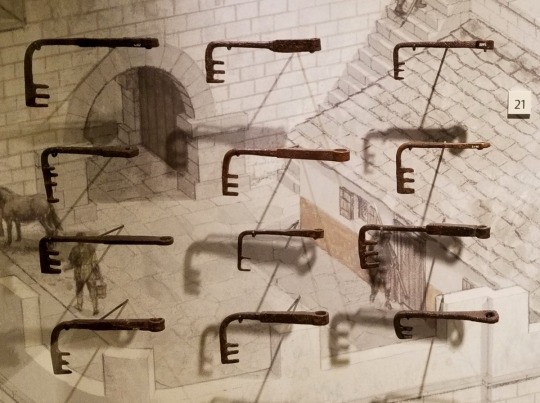
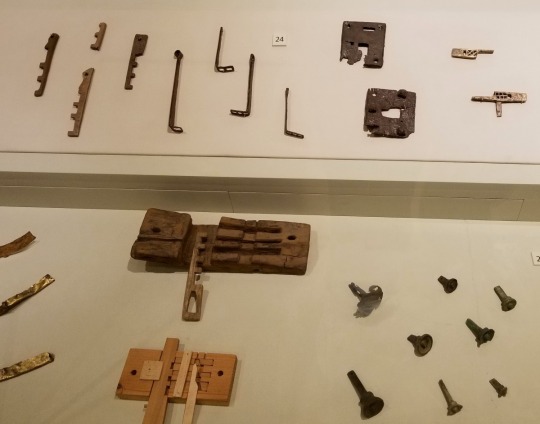
There was a fascinating collection of Roman locks and keys that were much more intricate than what I would have assumed they had at the time.
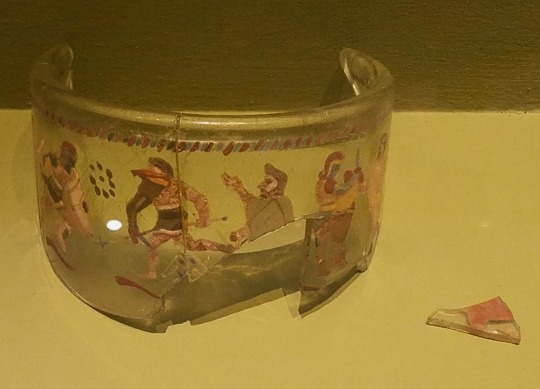
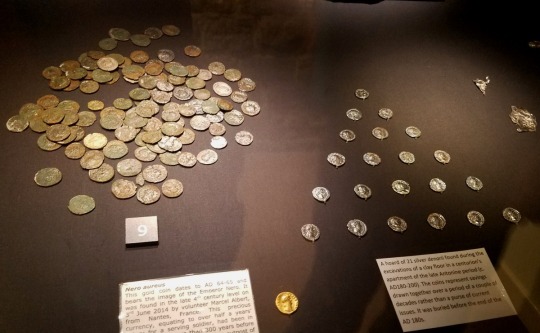
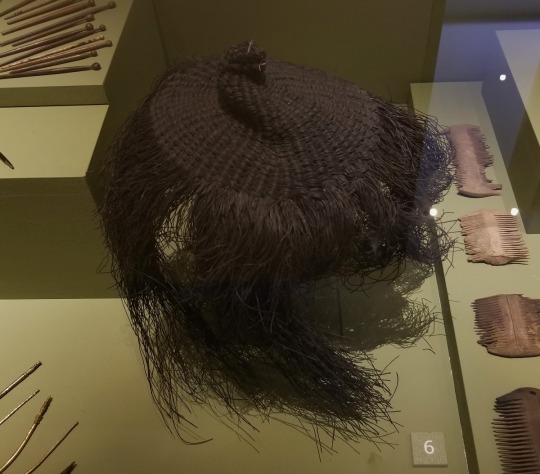
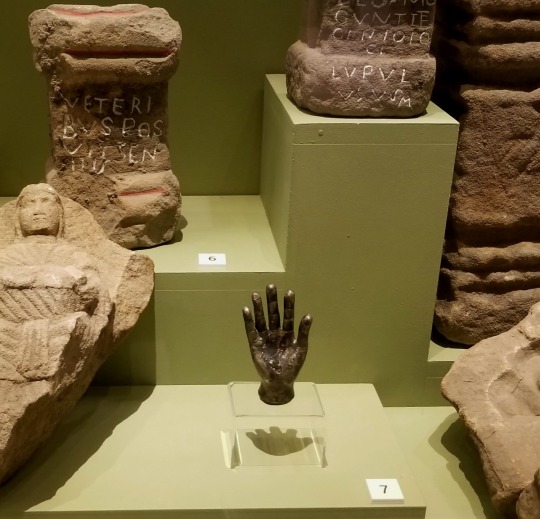
Other interesting finds in the museum included a piece of intricately painted glass that had been imported from Roman Germany, some surprisingly shiny Roman coins a bug-resistant wig made from local moss, and a small metal hand used for religious ceremonies.
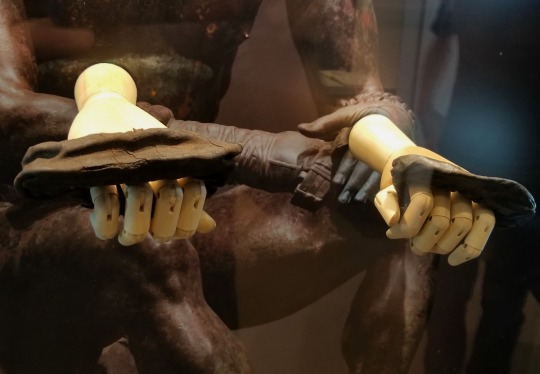
But the pride of the museum's collections was a barely distinguishable pair of leather boxing gloves. Boxing was a favorite pastime in the Roman Empire, and there are countless artistic depictions of soldiers and gladiators wearing an ancient form of boxing gloves. But these gloves found at Vindolanda are the only known surviving pair in the entire world.
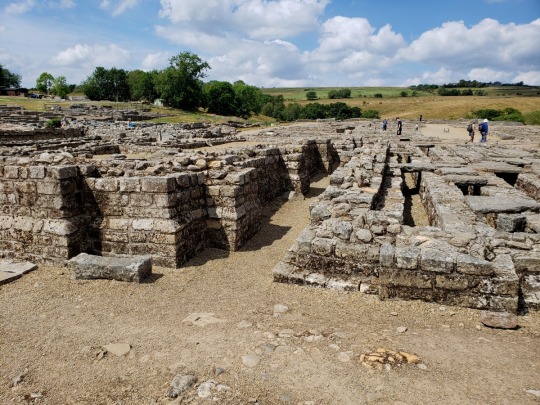

Normally, there is an afternoon guided tour of the ruins, but today's tour was replaced with a performance by a group of local Roman Legion reenactors.
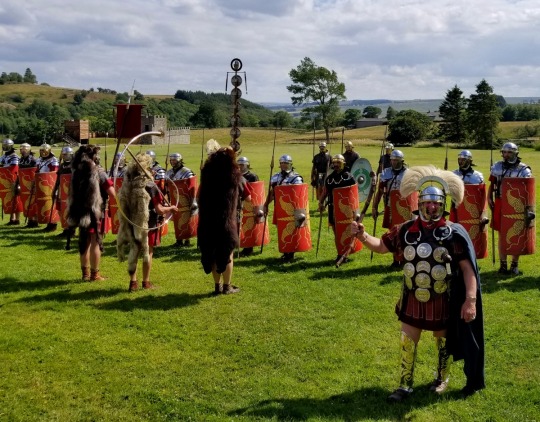
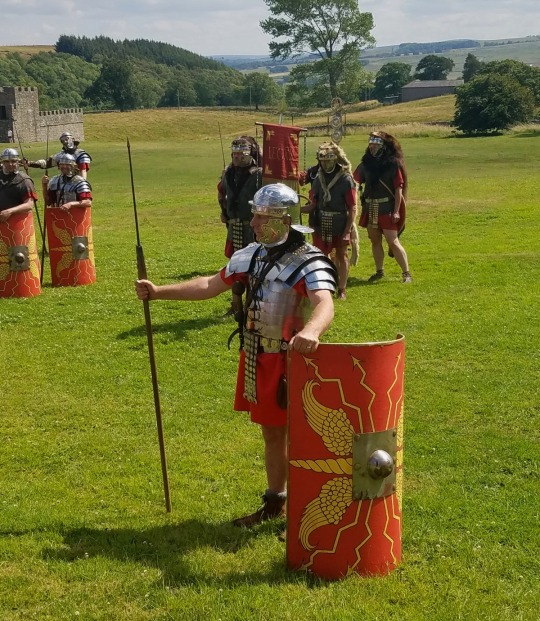
They described their arms, armor, and troop composition. We learned that up until the mid-20th century, historians didn’t actually know for sure how the iconic Roman segmented plate armor worked. It wasn’t until an old wooden chest under someone's house was discovered to contain two intact sets that people were able to accurately recreate them. And by recreating them, historians and reenactors can learn firsthand how they work and would likely have been used.
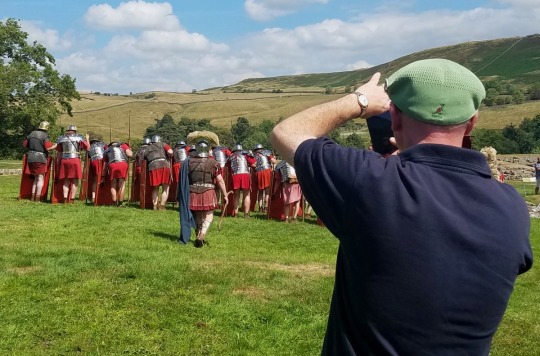
And you know you're in for a treat when your tour guide is excitedly taking pictures along with the rest of the group.
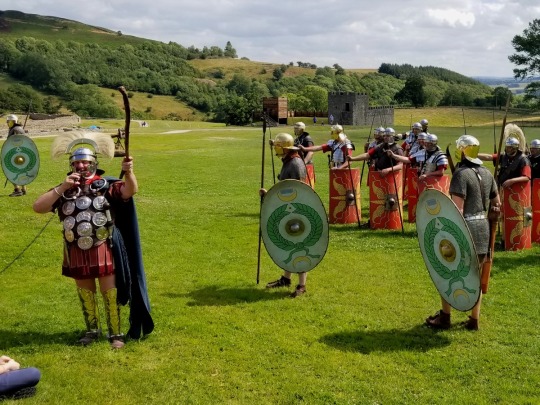
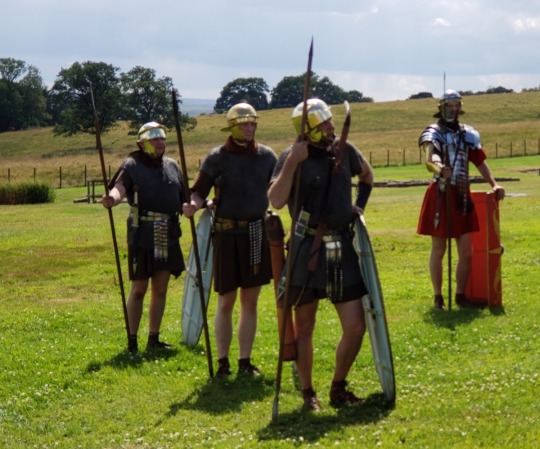
We learned how most of the soldiers manning Hadrian’s wall would not have actually been Legionnaires, but rather auxiliaries. Auxiliaries were non-citizen soldiers who fought for the Roman army in exchange for citizenship after 25 years of honorable service. In the meantime, they got less money, worse equipment, and more dangerous postings.
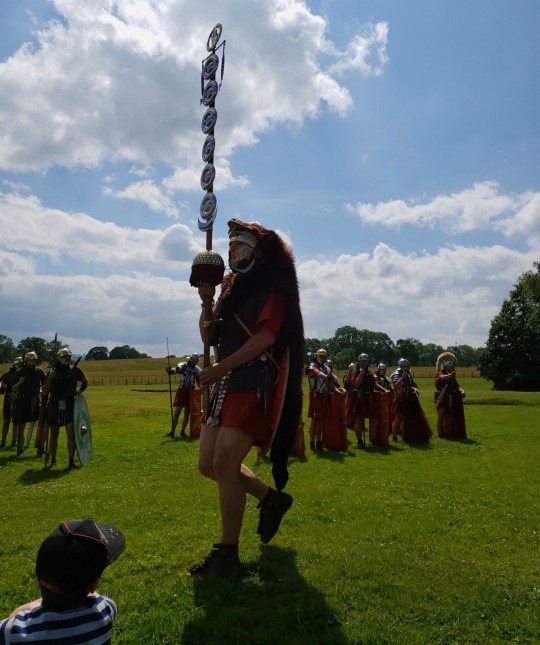
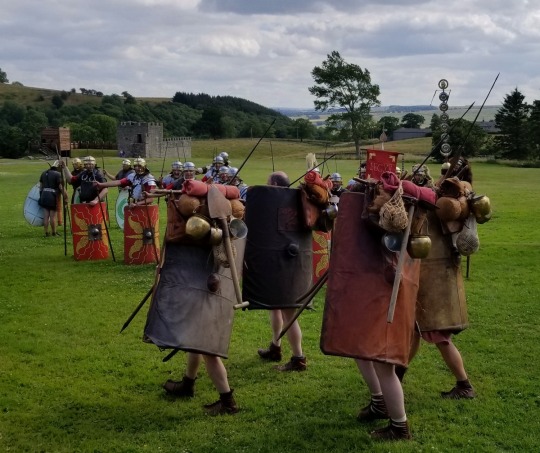
The reenactors also described how the invincibility of the Roman army was not just due to the superiority of their arms and armor. At the time, the Romans basically reinvented the idea of a professional, standing army. The Celts of Scotland had a proud and fierce warrior culture, but they didn’t really have armies. When one clan went to war against another, they would just gather all the able-bodied men together and head out. They were strong and fierce, but they just didn’t have the skills and tactics that full-time soldiers are able to develop through years of constant, structured practice.
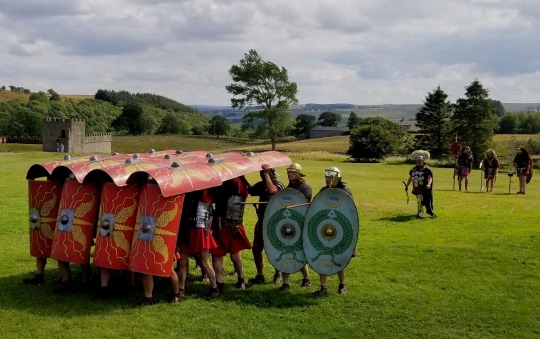
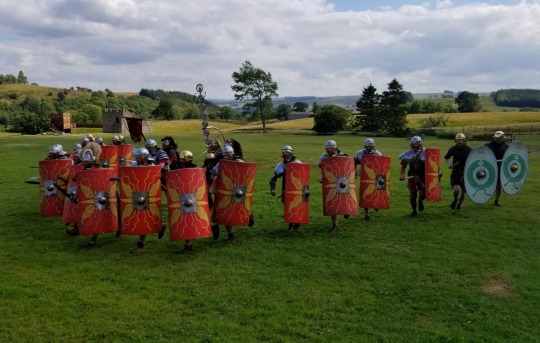
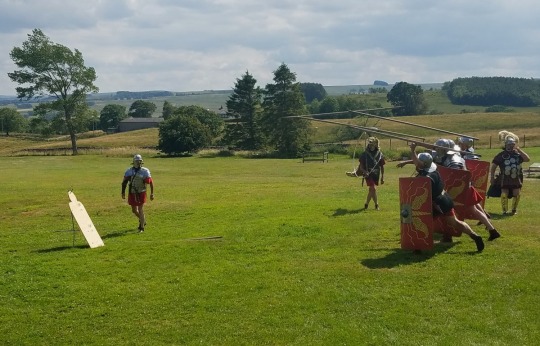
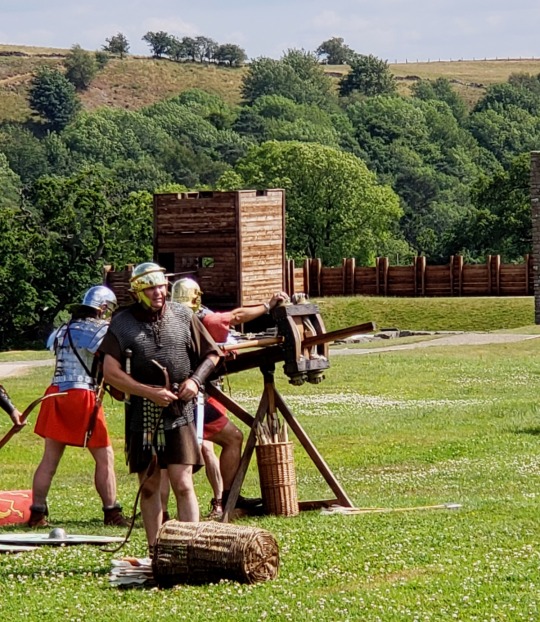
We got to see the reenactors charge, duel, throw spears, and even fire a ballista (basically a giant crossbow, for anyone who's never played Age of Empires).

Leaving Vindolanda, we headed back up to Edinburgh through the western Lowlands. Again, the rolling hillsides were spectacular. I was especially enthralled by the area around the River Tweed, the home of a famous British textile. We could easily see how the raiding parties Nik described could hide out in a fog-cloaked ravine and become virtually unfindable. Nik also pointed out the particular hillsides where the wild haggis love to run free--in circles, of course, because of their naturally lopsided legs.
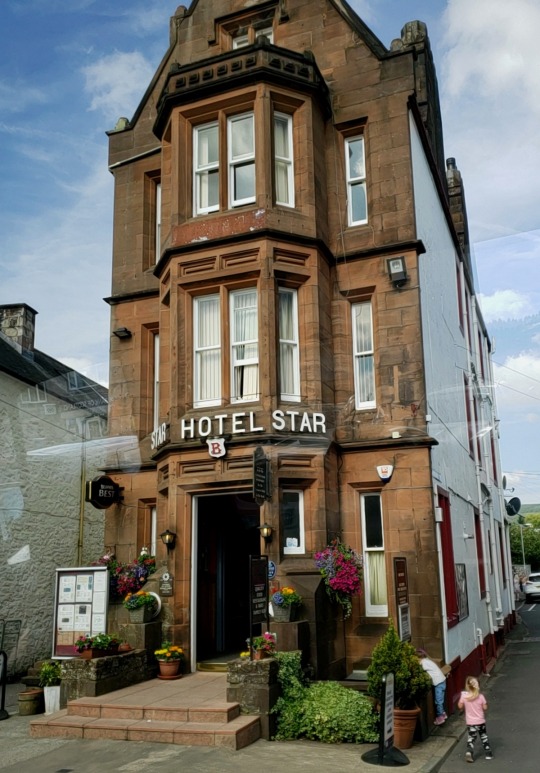
We also passed by the narrowest hotel in Britain.
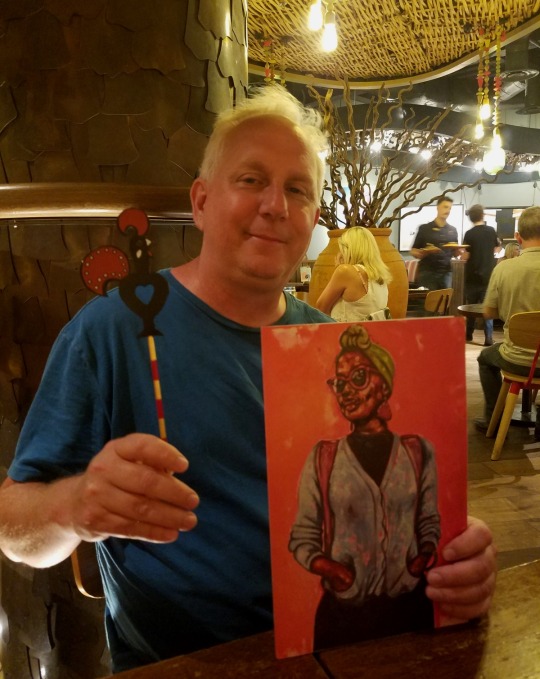
Back in Edinburgh, we finally got my dad his first taste of Nando's before heading back home. It was in a shopping mall at the edge of Old Town, and it was about an hour's wait between when we first put our names down on the waiting list and when we actually got our food. It was well worth it, though--especially considering that it would be our last Nando's of the trip.
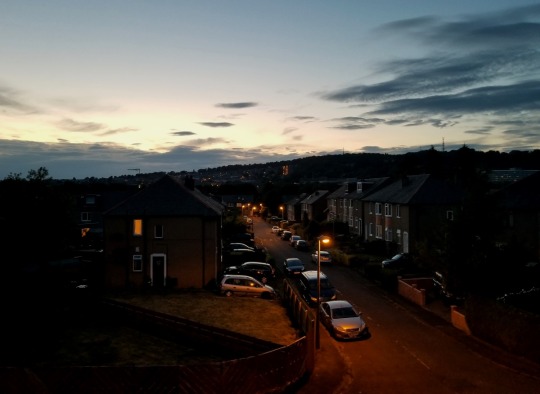
Back home, we rested up and prepared ourselves for our last two days in Edinburgh. We would be staying in the city, and we had almost all of it left to see.
Next Post: Edinburgh, Part 2 (History, Hiking, and Beer)
Last Post: Glasgow
#180abroad#edinburgh#scotland#lowlands#scottish borders#hadrian's wall#vindolanda#ancient#rome#roman ruins#history#travel
3 notes
·
View notes
Text
Ireland Impressions
I just returned yesterday from a five-day trip to Ireland with my daughter, Isabelle. She is applying to grad schools, and this last summer I let her know that I had AAdvantage miles that needed to be used. I thought she might use them to travel to interviews, but it turns out that in the world of Biology, the schools pay for prospective students to come interview. I realized yet again that I chose a difficult field--as a free-lance professional violinist, I’ve gotten used to paying to play, so to speak... Anyway, she suggested that we take a trip to Ireland. She works in a lab with someone who had gone there on his honeymoon, and he had very enthusiastically recommended that she go.
Without going into a lot of detail, Isabelle had a run-in with a virulent virus (I know that’s redundant) in September. The virus caused some frightening seizures which resulted in two hospitalizations. We weren’t sure that we would be able to go on our trip, scheduled for the end of November. So when Isabelle got the okay from her doctors, it was excellent news, in many ways.
We had held off making hotel reservations, but fortunately the end of November is off-season in Ireland. Ordinarily I would have done a lot of research to decide where to visit and where to stay, but the last-minute nature of our planning made that impossible. Maybe the more spontaneous approach to this adventure made it more satisfying. Also, thanks to crowd-sourced reviews of everything on the internet, gone are the days of toting guidebooks around. Our last big trip was to Munich and environs--eight years ago--and we definitely did that the old-fashioned way.
Okay, I’ll get on with it. We actually had five full days in Ireland, bookended by two days of travel. The airline travel was unremarkable, which might be remarkable, now that I think of it. Our plan was to spend one night in Dublin, two nights in Galway, one night in Cork, and the last night back in Dublin.
Day One: Dublin
Our hotel was just south of the River Liffey in the City Centre. We took a cab there from the airport and dropped off our suitcases so we could immediately start exploring. On our way to see the library at Trinity College, we ran across a cool exhibit of art books at a gallery. A good start. At the library we learned that only a facsimile of the Book of Kells (the famous medieval manuscript) would be on display that week. Not a big deal, especially since the library itself was awe-inspiring. I overheard someone saying something about Harry Potter, and we learned that they had shot a library scene there. It was also featured in one of the later Star Wars movies. Did that make it more meaningful to me? I’m almost ashamed to admit that it may have... We also visited the Guinness Storehouse in the early evening. It’s described as a “brewery experience”. A bit too theme-parkish for my taste, but I definitely know more about the process of brewing beer in huge quantities! The top floor bar where we had our complimentary pint has a 360 degree view of the city. We had two great meals that day, both at pubs. I have a much different impression of what pub food is now--many vegetarian and even vegan options.
Day Two: Dublin to Galway
A few days before our trip, I literally awoke in a cold sweat about driving on the left side of the road. My colleague Catherine had given this advice, to be used as a mantra: drive on the left and look to the right. We were picking up the rental car, and I would be the only driver--Isabelle isn’t able to drive for six months from the time of the last seizure. The weather was pretty intense--driving rain and wind. I thought it was charming that so many people apologized for the weather. We had escaped just before a big snow in Chicago, so I kept assuring folks that we had seen worse! The driving challenge turned out to be my position on the right side of the car. It took me an entire day of Isabelle saying “Mom, you’re over the line!” to get used to centering the car in my lane. Driving on the left side wasn’t as weird as I had thought it would be. And I think the roundabouts are brilliant. They keep traffic flowing, and cause fewer accidents than traffic lights.
We had breakfast/early lunch at Tyrrellspass Castle, and continued on to another castle at Tullamore--Charleville. Evidently, they have an annual music festival there called Castlepalooza. They were shooting a rock video when we arrived, and we weren’t able to go in, but the drive up to it was downright magical. That was a word that kept popping into my head over and over. The rain and temperate climate cause the vegetation to be green, even in late November. That, along with the mist and ancient trees, conjured up images of fairy tale enchanted forests.
We decided that we would go directly to the Cliffs of Moher since it looked like it would be rainy the following day. The drive up there was pretty harrowing. We were on rural roads that narrowed without much notice, and I was still trying to hone my new driving skills. What a reward when we arrived though! The cliffs at the edge of the Atlantic are ruggedly breathtaking. Because it was off-season and relatively late in the day, there were very few tourists. And there were sheep grazing right next to the trails--even a proverbial black sheep. They are the “Shaun the Sheep” type with the black faces, and both Isabelle and I are big fans. It’s too bad that today I started thinking about the fact that they are livestock and not pets...
When I started the car at the Cliffs, two warning lights came on. We looked them up--Electronic Stabilization Control and Emission Control. I figured we could make it to Galway, but we knew we would have to address the issue the next day. Thankfully, we did get there with no trouble. Our hotel was once again in the City Centre. About a block away was a Christmas market with food stalls and some carnival rides. Before we left home, I had wondered how commercial Christmas would be in Ireland. We learned that decorations generally go up a day after Halloween, so I guess that the US isn’t the only place that extends the holiday to last over two months. But to us, everything looked so quaint suspended over cobblestone streets. There is also an upscale Irish department store, Brown Thomas, that does some wackily inventive holiday windows. In Galway, one featured a male mannequin with an owl’s head. We had another great dinner--excellent farm to table food and a vegan local beer.
Day Three: Galway
We finally had a chance to sleep in! Then, unfortunately, we had to drop the car at an Enterprise-approved car repair facility for diagnosis. It was very close to the City Centre, so we walked to the Fisheries Watchtower (museum) and the Galway Museum. The wind was fierce--equal to anything I’ve experienced in Chicago, but that weather was over by 2 PM or so. At the museum, we learned about the ancient and more recent history of the city, including the Irish uprising against the British. I know through 23andMe that my DNA makeup is 41% British and Irish, the largest percentage in the mix. 23andMe doesn’t specify English, Scottish, Welsh, or Irish--I’m probably all of the above. We're pretty sure that the Hughes name comes from Wales, and our background is pretty thoroughly Protestant. I grew up with the impression that the Reformation was a positive thing, and that the Protestants held the moral high ground. But in this phase of my political thinking, my belief is that religious differences have most often been used to justify` the lust for power and the control of natural resources and goods. I also just finished an amazing book on the trip--”Fantasyland: How America Went Haywire” by Kurt Andersen. The US was founded by some pretty crazy Protestants, and I can’t take much pride in the ways that they behaved. Anyway, the visit to Ireland has led me to wonder what my ancestors’ political roles were in these struggles for independence.
We had savory pie for lunch--mine was kale and wild mushroom, locally sourced again, with spelt flour crust. Isabelle and I agreed that it was our favorite meal of the trip. We had to go back to the car repair place, and they informed us that we needed to get a replacement vehicle. This gave us the opportunity to talk with the lovely young woman from the Enterprise facility in Galway, the longest conversation we had with any local on the trip. The replacement car was newer and better, and they gave us a free day’s rental, so it was a win-win-win situation! We briefly visited the gorgeous Galway Cathedral where a nice man let us in even though they had just officially closed. We also heard some Irish traditional music, and ate at yet another farm to table restaurant. Incidentally, the prices were really reasonable compared to Chicago prices for similar food.
Day Four: Galway to Cork
Isabelle figured that Limerick would be a great place to stop on our way to Cork. We ended up spending much more time there than we had planned. After a great mocha (my first time trying oat milk) and breakfast, we went exploring. There was a mostly ruined castle, King John’s Castle, that had an excellent museum component that inspired more rumination on the conflicts between the different factions in the British Isles. And very nearby was the 850 year old Cathedral of St. Mary. Very impressive to us Americans when we’re inside a building with that kind of history...
We decided to visit Blarney Castle on our way to Cork, and it was much more captivating, and much less touristy than I had imagined. As we approached the castle on foot, we passed signs that read “90 minutes to the Blarney Stone”, “60 minutes to the Blarney Stone” etc. We were once again grateful that we were there in the off-season. Our wait to kiss the Blarney Stone was...0 minutes! Yes, we did it. There are many stories about the Stone, but the most common is that it gives you the gift of gab, and not in a good way. But I figure I can use the gift of gab--everyone always tells me that I’m too quiet and very private. Wow--it may already be working, since I’m writing this long involved post about our vacation! Surrounding the castle is a gorgeous park that is truly a botanical garden, including a poison garden. That traditionally would have had medicinal plants that “will either kill you or cure you.” There were huge redwoods, oversized rhubarb plants, a spectacular fern garden with waterfall--magical, you might say!
We went on to Cork, found our B & B, and went into the City Centre for another excellent meal. We wandered around, figuring out what we wanted to do there the next morning. There was a large courtyard with a light display called “Glow” that was set to open the next day. Also a ferris wheel that seems to be a standard part of a Christmas market--who knew? Our B & B was pretty cool, but the woman who ran it seemed disappointed that we hadn’t opted for the breakfast part of the equation. We had our sights set on a coffee place we had seen on our reconnaissance mission...
Day Five: Cork to Dublin
We did go to the Bean and Leaf, and it was very near to the English Market that we planned to visit. The English Market is a covered food market that houses a huge variety of fresh grocery items. We wondered about the origins of the name, and found out that the English or Protestant Corporation that ran Cork untl the mid 1800′s founded it. It catered to a wealthy clientele while the Irish Market catered to the working class folk. Now, everyone goes there, and they have all of the super-trendy foods that you would find in an upscale grocery store in the states. We bought a few things there, walked around a bit more, and got in the car to head to our last big adventure.
Almost as ubiquitous as the sheep on the hillsides were the rainbows. We saw a few every day that we were driving, including a couple of double rainbows. The conditions were perfect--light rain, followed by the sun breaking through the clouds. Now I understand the whole leprechaun and pot of gold at the end of the rainbow image. They seem so...magical!
I think it was the vinyl record store we checked out in Cork that got us onto the subject of rock operas. On our next car ride we listened to Pink Floyd’s “The Wall”. It was one of the few times we listened to music in the car. Most of the time the British-accented Google Maps lady was telling us where to go--”take the slip-road on the left.” Thank goodness for Google Maps! It would have been difficult to navigate all of those one-way streets with me driving on the left, using an old-fashioned map... Anyway, it was a pretty long stretch on a main road to get us to our next destination: the Wicklow Mountains at Glendalough. The same mountain range extends into Dublin where they’re called the Dublin Mountains. It was astoundingly beautiful there--and the smells were so fresh and fragrant. We hiked a very short trail that took about 50 minutes, but it gave us the flavor of the park. We had lunch at the Glendalough Hotel. And that reminds me--many of our servers, especially in the Dublin area, were young Eastern Europeans. Evidently, Ireland is a very popular place to look for better job opportunities, and a better life in general. We did remark on the fact that we saw very few people of color though. I want to find out why that is the case. It does make me wonder about ethnic and religious homogeneity. Would I have felt such an affinity for Ireland if I weren’t white and culturally Christian?
On the way down the mountain and back to Dublin, we listened to “Thick as a Brick” by Jethro Tull. Isabelle had never heard it before. I thought it had an appropriately Celtic feel, and was loosely in the rock opera genre. We listened to a few Irish artists as we were making our way back into Dublin in Friday evening traffic. We checked into our last hotel, did a bit of last-minute souvenir shopping, and ate at a pub with live music. The two musicians played mostly traditional Irish music, but also included a few American tunes. It was kind of a fitting transition since we would be heading to the airport in the morning.
I am so grateful that Isabelle was well enough that we could make this trip. She was a great traveling companion, and our energy levels were very well matched. We shared a similar idea of the optimum balance between planning and spontaneity. I’m not sure how to wrap this up except to say: Travel with your adult children! Go to Ireland in the off-season! Enjoy the rainbows!
2 notes
·
View notes
Text
Born to Run on the 4th of July
This tour is also available as an audio tour
I will always have an affinity for the United States of America. I suppose it is hard to explain why. I just quite like American things…
youtube
Steph and I travelled across America in 2013 and have been back a few times since. When we travelled we couch surfed which meant staying with strangers, all of whom were amongst the nicest people we ever met. For my 30th Birthday we went to Boston, where we got to see Salem on Halloween and saw the Chicago Bulls vs The Boston Celtics. Something I had wanted to do since I was a child.

I am fascinated by America; how different it all is yet how it’s all connected. It’s extremely distressing to see what a hellscape it has become. Especially for all the good people who live there. With this fascination in mind, I decided to look into Belfast’s historical connections to the US and how I could link these together into a route to run on the 4th July. I have been able to orchestrate a route of just over 14km (1km for each of the original 13 colonies and 1 for Belfast) that encompasses American history from ancient times to the present day. Including links to American slaves, US Presidents, Civil Rights activists and just regular Americans. The full route is below:
Route map for July 4th by Jonny Murray on plotaroute.com
We begin at Belfast’s Thanks-Giving Square, home of the 2nd largest outdoor sculpture in Belfast, the ‘Beacon of Hope’, also known as ‘Nuala with the Hula’ and ‘The Angel of Thanksgiving’. Sculpted by artist Andy Scott based upon an idea by Myrtle Smyth who was inspired by the Thanks-Giving Square in Dallas, Texas. The purpose of the Thanks-Giving Square was to provide a public space in which to give thanks. Our Thanks-Giving Square is more secular than its sister square in Dallas. With a focus more on the universal concept of gratitude and hope through positivity and acceptance. The sculpture has become an important landmark for Belfast since its construction in 2007 and serves as a symbol for Belfast’s international connections.

We then make our way towards the Waterfront Hall where the 44th President of the United States, Barack Obama addressed the Northern Irish people in June 2013. His speech echoed the sentiments of Thanks-Giving Square, calling for unity and peace in the city. Obama also called for the removal of the peace walls that divide the city, which we will get to a little later on the run.
youtube
We now turn right down Chichester Street which becomes Wellington Place and past the Belfast City Hall where the 42nd President of the United States, Bill Clinton addressed the people of Belfast while switching on the city’s Christmas lights in 1995. Much to the dismay of Belfast’s youngsters who were expecting the Power Rangers to have the honour of flicking the switch that year.
youtube
We now take a right at the Linen Hall Library, the oldest library in Belfast. Within the archives of the Linen Hall library is one of the oldest printed versions of the US Declaration of Independence which was published by the Belfast Newsletter in August 1776. This is not the only connection Northern Ireland has with the Declaration of Independence. John Dunlap was a native of Strabane in County Tyrone who moved to Philadelphia in 1757 at the age of 10 to work as an apprentice for his uncle who was a printer and bookseller. During the American Revolutionary war, Dunlap fought alongside George Washington and was awarded the contract of printing for the Continental Congress. After the Declaration of Independence had been signed, John Hancock ordered Dunlap to print 200 copies. These became known as the Dunlap Broadsheets and are the first published versions of the Declaration of Independence. The legend goes that a ship carrying the copy that was intended for King George III found itself in stormy waters and had to dock in Derry. This allowed the journalists of the Belfast Newsletter access to the document which led to The Belfast Newsletter being the first newspaper outside of America to publish a copy of the Declaration of Independence in full.

We now run down Fountain Street, right at Castle Street, left at Royal Avenue and onto Lower Garfield Street. Lower Garfield Street is named for the 20th President of the United States, James A. Garfield. Garfield was a veteran of the American Civil War, fighting for the Union Army. A strong abolitionist who had lobbied for strong punishments for those who fought on the side of the Confederacy. Garfield was seen as an American success story, having been born into extreme poverty but rising to the office of President through hard work and strong beliefs. During his presidency he had pushed for universal education to allow the newly freed slaves to have access to education that would ensure they would avail of equal rights. Garfield only served in office for 6 and a half months, as he was shot by Charles J. Guiteau in July 1881 and died from his injuries in September 1881.

We now leave Lower Garfield Street and take a right at North Street and then a left onto Warring Street. Warring Street, Donegall Street, North Street and Bridge Street make up what is known as ‘The 4 Corners’, this is one of the oldest parts of the city of Belfast. As it was a hive of United Irishmen activity during the Irish Rebellion of the 1790s it gave Belfast the nickname, ‘Boston of the North’ after the American city that became the birthplace of the American Revolution. Just off Warring Street is Sugarhouse Entry, where once stood the Benjamin Franklin Tavern, named for the American founding father who had visited Ireland and stayed at Hillsborough Castle before the American war of Independence. The United Irishmen would hold secret meetings in the Benjamin Franklin Tavern calling themselves The Muddler’s Club to avoid suspicion. A nearby restaurant is named in their honour and oil paintings of their meetings in the Benjamin Franklin Tavern can be seen at the entrance to the Premier Inn on Warring Street.

At the top of Warring Street, we turn right down High Street and left at the Albert Clock onto Queen Street and Custom House Square. This was once the site of Chichester Quay, the home of the first US Consulate in Belfast. Belfast is the 2nd oldest running US Consulate in the world after Bordeaux, France. The first U.S Consul General in Belfast was James Holmes, who is commemorated by a blue plaque on the wall of McHugh’s bar. George Washington personally signed the papers that elected Holmes as the US Consul for Belfast on May 27th 1796. The current US Consulate is located in Danesfort House, off the Stranmillis Road. Danesfort House sits upon one of the oldest continually inhabited sites in Belfast, with artefacts dating back 5,000 years unearthed during its construction.

We now cross the road towards the Big Fish and join the Maritime Trail to run beside the river Lagan. We follow the path until we reach the CEA building, where we will turn left through the car park towards Princes Dock Street which will lead us to The American Bar. The American Bar has been located at its current premises since the 1860s. Although there is no consensus as to how the bar, formerly The American Inn, got its name there is belief that it was named for the many emigrants leaving Ireland for the New World. The bar was also one of the first sites American GI’s would see when they arrived in Belfast during World War 2, acting as both a farewell and a welcome to Irish Americans.

We now run past The American Bar and left onto Dock Street. We come to the corner of Dock Street and Garmoyle Street. Here, above the door of the Stella Maris Hostel for the Homeless, is a tile mural titled ‘At Sea’. It depicts one of the oldest connections Ireland has to America, the fabled crossing of the Atlantic by St. Brendan in 600AD. The story goes that while St. Brendan was in his late 80s, he built a ship and sailed it across the Atlantic Ocean in search of the Garden of Eden with a crew of between 80 – 150 men depending on which version of the story you’re told. Brendan recorded seeing pillars of ice rise out of the water, sheep the size of oxen and giants throwing balls of fire at them that smelt of sulphur. He also came across birds who would sing psalms, before finally landing on a country of lush green vegetation. After 7 years an angel advised Brendan and his crew to return home to Ireland. When they returned, they recounted their tale to everyone, and people would come from all over Ireland to hear Brendan’s tales of the new world. Historians began recording Brendan’s voyage and the island he described was included on maps. Christopher Columbus even used the legend as a basis on his journey to the Americas. While Brendan’s story may seem like fantasy, it has been interpreted to contain some elements of truth; the pillars of ice would have been ice bergs, the Faroe Islands are known to have large sheep and the singing birds and fireballs of sulphur could have come from Iceland’s volcanoes. As well as this, in 1976, adventurer Tim Severin recreated Brendan’s journey. By building a boat to the medieval specifications and setting off from the Dingle peninsula he successfully arrived in Newfoundland. So perhaps it is not a complete fantasy that an elderly Irish monk arrived on the shores of ancient America.

We now continue down Dock Street, take a left at York Street and take a right past The City Side Centre to go down Henry Street, at the top of Henry Street we will take a left and cross the road towards the steps at North Queen Street. Head straight up these steps and follow the path round to Henry Place. This brings us past Clifton Street Graveyard, one of the oldest graveyards in the city and burial ground of the Irish Revolutionaries, Henry Joy and Mary Anne McCracken. Within this graveyard also lies William Brown, a black American who escaped slavery in America in the early 19th century and worked as a labourer in Belfast. The Clifton Street Cemetery records indicate that his wife and children remained as slaves in America at the time of his death in 1831.

We now head towards Clifton Street and then right towards Carlisle Circus and cross over towards Denmark Street. We will follow Denmark Street until we reach North Boundary Street. Here, turn right down Shankill Parade and then take a left down Boundary Way. At the end of this residential street is a community mural. Formerly a mural depicting the 7th President of the United States, Andrew Jackson, it now bears a quote from the President of the Louisiana Justice Institute, Tracie Washington (Not ‘Jackson’ as is depicted on the mural), “Stop calling me resilient,” “Because every time you say, ‘Oh, they’re resilient,’ that means you can do something else to me. I am not resilient.” Tracie Washington delivered this statement as a response to the New Orleans City Resilience Strategy in 2015 and their plans to tackle the continuing environmental crisis in Louisiana, which did not address the root cause of the issues. Her argument was succinctly summed up by Maria Kaika, Professor of Human Geography at the University of Manchester; “if we took Tracie Washington’s objection seriously, we would stop focusing on how to make citizens more resilient ‘no matter what stresses they encounter,’ as this would only mean that they can take more suffering, deprivation or environmental degradation in the future. If we took this statement seriously, we would need to focus instead on identifying the actors and processes that produce the need to build resilience in the first place. And we would try to change these factors instead.” This statement has been adopted by the people of the Shankill who feel the problems that face their community are not addressed due to a perceived resilience of the people.

We then take a left to return to North Boundary Street and take a right onto Shankill Road. We follow the Shankill Road up to the corner of Lanark Way. We follow Lanark Way toward Cupar Way where we will take a left to run along the Belfast Peace Wall. On this wall we will see the message of President Bill Clinton, “Strength and wisdom are not opposing values”.

Bill Clinton visited Belfast in 1995, becoming the first sitting US President to visit the province. He was greeted as a rock star with thousands of people lining the streets to get a glimpse of him. Below is a video of him visiting with Gerry Adams in a small office on the Falls Road. The Presidential cavalcade making its way down the Falls Road is a truly surreal sight.
youtube
We follow the Peace Wall down to the end of Cupar Way and take a left onto North Howard Street, a right onto North Howard Link and right at Northumberland Street. Here we come to the Solidarity Wall and the mural depicting the freed slave and American abolitionist, Frederick Douglass. Douglass visited Belfast many times during his life to speak to the city at the invitation of the United Irishmen. He would use Belfast as an example of a Western city where racism was not as prevalent as it was in America and would speak to large crowds in the city and received a warm welcome. A handwritten copy of a speech he delivered in Belfast is available to view on the Library of Congress website. The rest of the mural depicts individuals involved in the American Civil Rights movement, including Rosa Parks and Martin Luther King Jr. It is interspersed with figures of international civil rights such as Nelson Mandela and Mary Anne McCracken. As well as a quote from Abraham Lincoln, the 16th President of the United States. Douglass’s placement in the centre of the mural illustrates how the struggles for civil rights began with the abolition of the slave trade. He is also facing the Peace Wall, a reminder that unity and civil liberties have still not been achieved.

We follow the Solidarity Wall left onto Divis Street. Here we see the most recent addition to the wall, a Black Lives Matter mural, depicting the murder of George Floyd by police in Minnesota. This murder sparked international protests during the pandemic of 2020 and has led to calls for sweeping changes to American policing and self-reflection about race relations in America and across the world.

We continue on Divis Street before turning right onto Ardmoulin Street, left toward Clonfaddin Street and right onto Cullingtree Road, we will then cross over the pedestrian bridge toward Durham Street. We take a right on Durham Street, a left on College Square North and then a right onto College Avenue. We will follow this road as it becomes Great Victoria Street and we pass the Grand Opera House. The Grand Opera played host to General Dwight D. Eisenhower, the 34th President of the United States, although at the time he was in Belfast as a General during World War 2. He was in attendance at the Grand Opera House in 1944 during a production of Irvine Berlin’s ‘This Is The Army’ performed by the US Army. Eisenhower was also presented with the Freedom of the City of Belfast later that year.

We now follow Great Victoria Street towards Bradbury Place and on to University Road towards Queen’s University Belfast where former US Secretary of State and Presidential nominee, Hilary Clinton was made Chancellor in January 2020.

We then take a left into Botanic Gardens. Now this a somewhat tenuous link to the United States, but bear with me… Charles Blondin was a French tight-rope walker who found his greatest fame in America when he walked across the Niagara Falls on a tight rope, 1,100ft long, 3.25inches in diameter and 160ft above the water. He would walk back and forth across the rope, each time performing a different stunt such as pushing a wheelbarrow before him and even stopping midway to cook and eat an omelette. Abraham Lincoln compared himself to Blondin during the 1864 Presidential election claiming he was like ‘"Blondin on the tightrope, with all that was valuable to America in the wheelbarrow he was pushing before him’.

Blondin lived in America for most of his life but toured Britain and Ireland extensively. While in Dublin in 1860, a rope broke during his performance which led to the collapse of the scaffolding that was holding the rope in place. This led to the death of 2 workers who were on the scaffolding at the time. Due to this incident, Blondin began using rope made at the Belfast Rope Works and did so for the rest of his career. He performed in Botanic Gardens many times throughout his career, the first time being in 1861. He even had his last ever professional performance in Belfast’s Botanic Gardens in 1896. Where he walked across a tight-rope at age 72 while blind in one eye.

We now leave Botanic Gardens and onto Stranmillis Embankment and over King’s Bridge. King’s Bridge suffered structural damage during World War 2 caused by heavy American Military Vehicles crossing over it. After the bridge we turn left and run down Annadale Embankment towards Ormeau Park. American GI’s were stationed in Ormeau Park during World War 2. It acted as a camp and training ground for the American military. We then head up the Ormeau Road with the park to our left, as we take a left down Park Road, down Ravenhill Park and finishing at the corner of Ravenhill Park and Onslow Parade, the site of Kingspan Stadium, formerly Ravenhill Stadium. Here is where the first games of American Football and Baseball were played in Ireland. On 14th November 1942, American soldiers played the first game of American football to a crowd of over 10,000 people. They competed under the team names ‘Yarvard’ and ‘Hale’ with the American Col. Maurice J Meyer introducing the game and providing running commentary for those in attendance. Hale won the game 9-7 with a field goal sealing the points.

The first baseball game took place in April 1942 between US 2nd Battalion and 3rd Battalion in front of a crowd of 1,000 people. Major General Russel P Hartle, Acting Commander of the US Army in Northern Ireland threw out the first pitch. Like the football game, running commentary was provided over loud speakers for the audience. 3rd Batallion emerged victorious with Corporal Leo J Robinson becoming the first serviceman to hit a home run in Europe during World War 2.

And so we have come to the end of our 4th July run. Hopefully you aren’t too tired, though it’s understandable as you have just run the length of American history. When researching the connections America has with Belfast, I found it interesting that America is somewhat of a unifying force in such a divided city. All parts of the city enjoy some notable connection the US. It can even bring politicians together, with Sammy Wilson sitting beside Gerry Adams during Barack Obama’s speech. This is ironic, because America itself is so divided, arguably it’s broken. As has even been illustrated on the walls of Belfast with the highlighting of racial and social inequalities that continue to exist in America. Inequalities that have been magnified during the current pandemic. With that in mind, I would urge everyone to educate themselves on these issues and find ways for you to make little changes that can contribute to addressing and solving these issues. As has been seen from this run, our countries have an impact on each other so let’s make the impact positive.
After the run, I recommend putting your feet up and watching Hamilton on Disney+. Probably the best way to spend your 4th July.
youtube
Sources: https://wartimeni.com/,https://extramuralactivity.com/, Weird Belfast by Reggie Chamberlain-King, Wikipedia, https://www.inyourpocket.com/belfast, https://edgeeffects.net/stop-calling-me-resilient/, BBC, https://www.culturenorthernireland.org/
0 notes
Text
“Oh, you daft bat!”

April 21, 2019 (Sunday Evening) I’ve decided the title of each one of these posts are going to be my British phrase of the week. “Oh, you daft bat!” occurred today, as a fellow student and I were entering a very small church for Easter service. The woman who picked us up, Angela, was greeted by Bonnie, another member of the congregation, in an Easter egg hat and that was Angela’s reaction to it. There was instant laughter, and it was the best way I could have started my day. Well, a week has come and gone! Most of the students here are having a hard time processing that. Time that I initially thought crawled by is already propelling forward at an alarming rate. The first 7 days have been a little unique, and filled with a lot of adjustment. So now that we’re settled in, jet lag has faded, and we’re able to focus on the budding friendships, all we are hoping for is more. More time. More hours in the day to lay out in the grass and read. Longer curfews and later wake up times for extended conversations. Additional outings and opportunities to explore this piece of paradise nestled along the coast within the English countryside. I’m sure it comes as no surprise that I’m absolutely in love with this country. I had only really seen it in movies, and I always wondered if it was accurately depicting the England I imagined. It’s always a pleasant surprise when reality surpasses the dream, but no picture I take can truly do it justice. Every drive consists of lots of green, endless rolling hills, livestock, flowers, and even the occasional ocean. The air is fresh and alive, with an acceptable hint of the resident sheep, cows, and horses.The rural cottage style housing is all over, even in the big cities, brick and wood paneled houses line every street. Each one seems to have a old-fashioned almost medieval door, a nook cozily shaded by sheer lace curtains, and ivy crawls across most entry ways. I’d move into any or all of them in a heartbeat. On top of that, I’m surrounded by all my favorite accents of all time. For those of you who think I’m going to come back with one- don’t worry. There are too many here to develop a single one. The accents of the most obvious, those from Britain, vary among the students and staff from Lancaster, Manchester, Liverpool, Yorkshire, and London. Some are smooth and soothing, others are so thick you nearly have to translate. Then there is 75% of the entire country of Canada here, battling it out for which part of it is the most legit, and whether ending a sentence with “eh?” or “hey?” is correct. After that, there are German, Irish, French, Austrian, Brazilian, Danish, Swiss, Australian, South African, South Korean, and Spanish students. Talk about a melting pot! I’ve been writing down words and terms I’ve heard that just fill me with pure joy every time I hear them and while there are too many to count, I’ll share some. Everyone says my name differently, and I love it. They use the word “loo” for bathroom regularly, and instead of replacing a thought that is slipping with “um” they say “ehm”. Those with particularly thick accents release us to get “teh and coffeh” every morning. A speaker called someone a “cheeky monkey” in class the other day. My roommate, who is from Belfast says “wee” all the time, especially when we take “wee little naps”. Many of them use the word “flip” to replace a curse word, and I just about lost it when that same roommate exclaimed, “Oh for flips sake!” in her wee little Irish accent. Oh, and they call snacks “nibbles”. Safe to say I’m happy being here. I’ve been able to distance myself from the daily worries of home, and focus inward. As of yesterday, I’ve cut off communications with home for a bit, aside from sites and apps I can post updates on. Mostly because I found I began every day with a dose of a life I’m thousands of miles away from, checked up on it throughout the day, and ended with it at night. My mind and heart got pulled back daily, to things that don’t need or deserve my attention, even as this incredible place called out to me to join it completely. So don’t take it personally if I don’t respond, it’s been an incredible feeling to disconnect and I’ve already felt a weight lifted and doors open because of it. Friday, we had our first of two “Family Nights”. This is when our small family groups and leaders meet and do something together, usually away from school. Ours went to Morecombe Bay, and strolled the boardwalk along the beach and took silly pictures. You’ll be able to see many of them in my Capernwray 2019 album now, but it’s safe to say we had lots of fun. So many laughs and stories that I plan on bringing home from that one evening on the coast and Dino’s flat where we talked, played games, and ate baked apple strudel (best said in a German accent) with ice cream. Such a simple night, but truly memorable. We went to the city of Keswick (pronounced Kezzick) Saturday, and spent the day surrounded by gorgeous lakeside views and hundreds of dogs. They were literally everywhere, at least 5 in sight at all times. Felt like actual heaven. I was legitimately amazed at the amount of off leash activity though, felt so different from back home. Very laid back and a lot of trust was extended, not just with other dogs, but with the community to respect boundaries. Spent most of my time with a married couple named Melissa and Jonny, who are from Canada and learned all about their story, and their plans to serve missionaries as a pilot for MAF after school. Incredible couple and individuals, not to mention very easy to talk to and get to know! Definitely people that are able to form fast friendships, and I’m very grateful to have been one of them! Easter Sunday was one for the books. I went to Warton Methodist Church, a congregation of maybe 20-30 people, of which we were the youngest by maybe…40 years. You might think, “Oh, she’s just exaggerating,” and while I appreciate a flair for the dramatic, there is none needed to describe this wonderful place. Our names were printed in their programs, and they welcomed us into their small family with open arms, and tea and biscuits. We met Elsie, Norman, Paul, Bonnie, Polly, Russell, and a few more who chatted with us, complimented our accents (what?), and shared their stories as well as their church home. It couldn’t have been more different from home, and I loved every second of it. There is so much more I could write about. So many conversations and friendships with people that I am just so genuinely grateful for. The support, love, and friendship I’ve received from my roommates even in first week is unparalleled. Purposeful. This place is intentional. Not a minute goes by wasted, and it’s such a refreshing feeling. I’m surrounded by constant reminders of Love beyond this world, Love that won’t fail or disappoint. Love that heals, and Love that chooses me every day. And the craziest thing is- this is just the beginning! See you next week,
Mal
0 notes
Text
June 28-29, 2017
Strap in for a long post because these last few days have been BUSY. (This reminder is as much for me writing this post as it is for you reading this post.)
Yesterday (Wednesday the 28th) began with an early morning bike ride down to a local lighthouse with Cuchulain and Claire. Well, I should probably rephrase that: the original goal was to get to the lighthouse, which Google Maps insisted would only be a twenty-minute bike ride. However, it started raining fairly aggressively shortly after we began biking through the streets of Dublin, causing our sense of direction to get way off and resulting in a number of wrong turns that severely diminished our confidence. In fact, we did end up seeing the lighthouse, but it was off in the distance mostly hidden by the iconic Irish fog. After seeing this faint red outline of the lighthouse so far away from us, we decided to turn and head back to the apartment in order to finish getting ready for our road trip (woot woot) to Blarney! I ended up taking a bit longer than everyone else because I was a dummy and hadn’t packed the night before, but by ten thirty, all of our luggage for the weekend was packed in our rental car and we were off!
The car ride there was fairly uneventful, although the scenery next to the highway is much different from what you’d find next to I-77. Following about three hours in the car, we arrived at Blarney Castle with plenty of time to spare for lunch, which we ended up enjoying at the Blarney Café right outside the gates (a lovely establishment, by the way). It was a really nice way to be able to decompress and relax after such a long time in a confined space.
But enough about the small details, let’s talk Blarney!
Blarney Castle itself actually ended up being a very small part of the whole Blarney experience. The grounds seem to stretch on forever and I spent a lot of my time in the Rock Close, which contained a bunch of old Druid sites from times way before Blarney Castle was even built. A lot of it was clearly done up for tourists, but it still passed off as really magical, especially when walking through it on my own.






And yes, I did kiss the Blarney Stone. How could I not when Mom and Dad have been talking about their experience kissing it for the last fifteen years?
In all seriousness, despite the nearly-hour-long wait to get up to the stone, it was definitely worth it, primarily because I felt very proud of myself for kissing the stone despite my fear of heights.


The seven of us met back up in the Blarney gift shop at about five p.m. and hopped back into the car to make the hour-and-a-half drive to Bunratty, which would be the finale to what Dad excitedly called “castle day.” We were able to relax in our newest Air B&B, an adorable house in a suburb near the castle, for about an hour once we got there, a welcome break to our busy day. But, because relaxation is for dweebs, we quickly whisked ourselves out the door once more around eight p.m. and piled into the car for the short ride to Bunratty Castle.
We were actually going to have a medieval dinner in the castle, which sounded really awesome and ended up being REALLY awesome. There were several actors dressed in medieval-style clothing there to greet us and hand us mugs of mead as we walked in the door, the latter of which proceeded to make Mom squeal with excitement because she has literally been waiting to taste Bunratty mead again for the last fifteen years. We were guided into a sort of waiting room with the other groups that were there that night, which was gorgeously decorated. There were really detailed fifteenth-century tapestries on each wall, as well as a gorgeous “dowry wardrobe” that was leaning against the right wall as we walked in. A dowry wardrobe was apparently a piece of furniture that a rich family would begin constructing when a daughter was born into the family, which would then be continuously added onto until the girl was married off. The final piece carved into the wardrobe would be the crest of the husband’s family.
After a about twenty minutes in the waiting room, we were directed into the main dining room. This room ended up being packed wall-to-wall with people, a fact that no one seemed to mind because at least seventy-five percent of the room’s population was slightly tipsy or just about there. The atmosphere was warm and energetic and everyone was super into it once the actors started announcing the various skits of the evening. The food was delicious as well and the madrigal singing that the actors performed throughout the night was beautiful. Special shoutout to the harpist, who absolutely killed all of her solos.

We left Bunratty in incredibly high spirits with a lot of quality spirits. (Get it? Because we took some mead with us.)
Today (Thursday the 29th) was quite possibly one of my favorite days of this entire trip. We didn’t get out of the house until about eleven-thirty when we headed into Limerick for a nice family brunch. We wound up at this restaurant called Hook & Ladder near City Centre. When I say this place was adorable, I mean that this place was so cute, you’d want to wrap it up and take it home with you to look at when you’re feeling sad. There were these two booths along the back wall of the bottom floor that were separated by a wall of very realistic tree branches stretching up to the ceiling and connecting with these strings of old-fashioned spiral lightbulbs. It was altogether very homey and the food was amazing as well.

During brunch, Claire came up with the idea to go on a boat tour around the Killary Fjord, which was around an hour and a half away from our final destination for the day. A boat tour sounded like a new and exciting experience to us all, so we eagerly agreed and planned to make it to the four-p.m. tour. Our original plan was then to find something to do as we drove through Galway, but due to a bunch of delays on the roads in Galway, we ended up having to just drive straight through in order to get to Killary on time.
I then fell asleep for about an hour, only to open my eyes to the most beautiful countryside view I had ever seen. Travel guides are not kidding when they say Ireland has the most scenic road trips in the world. Several of us gasped when we saw the mountains, including Cuchulain, who seemed to be unable to stop saying, “Oh wow.” In all honesty, he was just saying what we were all thinking.
(Complete side note: About twenty minutes from our tour meetup point, our path got blocked by a bunch of escaped sheep, who paid absolutely no mind to us. We all found that really amusing.)



The crazy thing is that those views weren’t even the best part of the day.
We made in to the boat tour office about ten minutes before we needed to be there and got a taste of what we were going to see over the next hour and a half. It was breathtaking, to say the least.

About ten minutes after four, the seven of us walked onto the boat and our journey began.
I cannot even begin to express all the different ways that this place was beautiful.
It was super windy and cold, but it really didn’t bother any of us at all because the air felt awesome running through our hair as we stood at the front of the boat. There was one moment when the majority of us were standing at the front, clearly starting to feel the effects of the cold, and Dad walked out with a bunch of hot chocolates from the boat’s built-in bar. I can definitely say that there was nothing else that could have made those next few minutes anymore perfect. Hot chocolate, a perfect view, family around me: it was, in a word, fantastic.
The entire hour and a half was filled with amazing views. The only way to properly describe them is to show them to you.





See what I mean?
We also got a lovely man on the boat with us to snap this picture of us, which I think is absolutely precious.

At the end of the tour, we were all thoroughly exhilarated and exhausted at the same time, which didn’t end up being a very good thing for our nerves as we drove through the narrow roads of the Irish countryside. However, we ended up making it safely to Westport, a popular tourist/vacation spot along the west coast, where we decided to have dinner. We settled on a lovely Italian place, which gave us another chance to decompress before getting back in the car for another hour-long drive.
On this last leg of the journey before reaching Achill Island, which is the destination of the half marathon that Dad, Cuchulain, and Claire are running this weekend, Cuchulain decided to start up some car games. These didn’t end up going in his favor, much to his frustration as time went on with no wins to his name. However, he couldn’t be too upset because the views outside our windows started looking unreal again.


I am now typing this post from a delightfully cozy cottage a little way up the mountains in Dooagh, one of the towns on Achill Island. As a conclusion, I’ll leave you with this high quality picture of some sheep that blocked our way as we drove into town.

Prospective plans for tomorrow: exploring???
1 note
·
View note